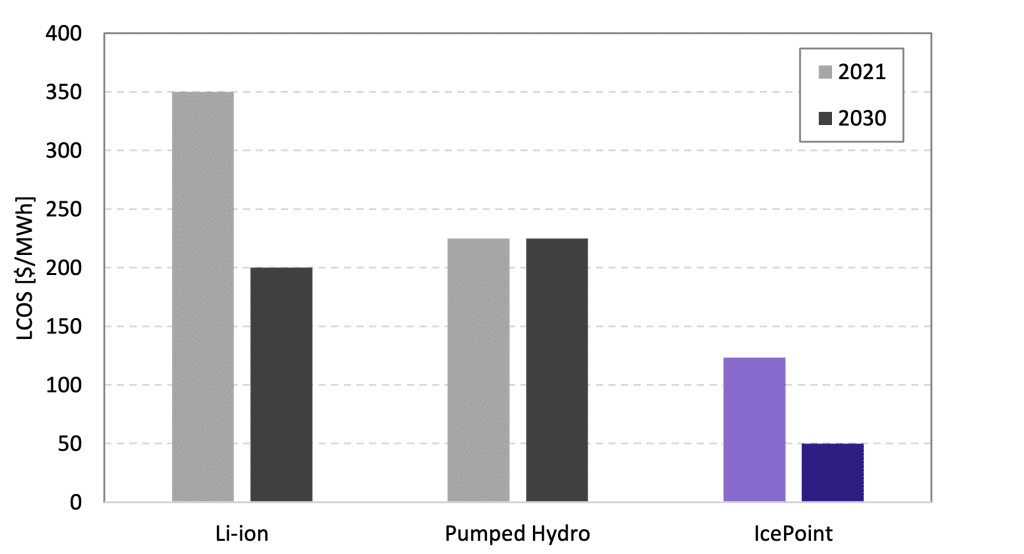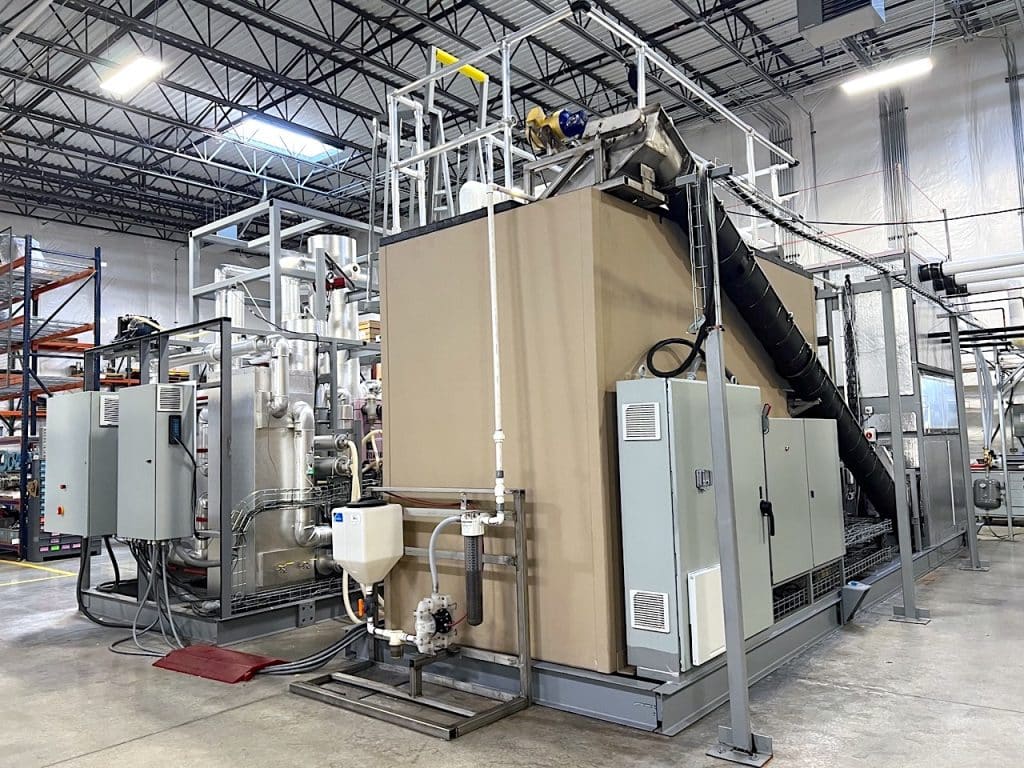
Rebound Technologies
October 2022
SUMMARY
The decarbonization of our electrical infrastructure and move from fossil fuels is already proving to be painful. One obvious solution is to install trillions of dollars of batteries in massive greenfield construction projects across the country. While this solution is easy to understand, it is brute force and environmentally costly. There is a far simpler solution: create flexible energy consumption.
Throughout the United States, there are thousands of cold chain facilities with energy consumption on the MW scale. Given their massive electrical loads, each of these facilities has the potential to serve as an energy storage asset for the grid, enabling flexible energy consumption. Rebound’s IcePoint can make that happen. IcePoint is a paradigm shift in demand response, TOU rate mitigation, and energy storage. IcePoint units generate only a small fraction of their value from arbitraging TOU rates or demand charges. Instead, ROIs of 2-3 years can be had by increasing customers productivity, operational efficiency, and profit through better temperature fluctuation control and facility dehumidification. But also inherent to IcePoint’s technology is the ability to store thermal energy and support cold chain facilities as if IcePoint were a battery, but instead of deploying electrons on demand IcePoint deploys thermal energy (cold) on demand. This is very similar in concept to HVAC ice banks for building air conditioning where ice is made at night when power is cheap and provides cooling during the day when power is expensive.
Once rolled out across cold storage, food processing, and food retail markets IcePoint can enable more than 800GWh (100X more than today’s installed batteries) of energy storage at a cost far below batteries and even pumped hydro.
INNOVATION AND IMPACT
The current (and decreasing) costs of renewables will drive massive adoption over the next 30 years necessitating significant investments in grid storage and flexibility. To capture the value of low-cost renewables, 600-1200 GWh of an equally low-cost storage technology is required1,2 . To be implemented, this storage technology should have a levelized cost of storage (LCOS3 ) well below that of pumped hydro energy storage (PHES) in a 4-12 hour diurnal arbitrage scenario. To date, no such technology is on the horizon. PHES, the only 4-12 hour storage technology deployed at scale today, has an LCOS of $225/MWh and is not projected to see any meaningful LCOS cost reduction in the next 10 years4 . Li-Ion batteries, despite their recent cost reductions, have a LCOS of $350 /MWh today and are expected to reach an LCOS of $200/MWh by 2030 4 . Costs for all three systems are shown in Figure 1.The first commercial scale IcePoint unit, which is currently operational, has a proven LCOS of $120/MWh.

Figure 1: Current and 2030 LCOS values in a renewable integration role.
IcePoint achieves such low storage costs because it takes a fundamentally different approach to energy storage: it generates revenue and lowers costs for the customer primarily as a superior refrigeration and dehumidification asset and secondarily as an energy storage asset. It represents a new form of refrigeration heat pump that uses brine-ice mixtures to provide low temperature refrigeration to the cold storage, food processing, and food retail markets. This new heat pump cycle is called a freeze point suppression (FPS) cycle. The primary value of FPS cycles is derived from matching customer thermal transients and providing moisture control within the customer’s refrigerated space. However, since these cycles use cheap and easy-to-store brine and ice-based refrigerants, they can be scaled up to provide grid storage at a very low cost. Thus, IcePoint’s energy storage cost is only the incremental cost of adding additional thermal capacity to the system and has a significantly lower potential cost then stand-alone energy storage solutions like Li-ion, PHES, and Vanadium flow batteries. The additional capacity consists predominantly of a larger tank and more brine both of which are cheap.
Currently IcePoint is at a TRL 8 with the completion of a 10kWth pilot system operated at a cold storage facility in Oxnard CA and the first 100kWth commercial system under Factory Acceptance Testing at Rebound’s facility.
Figure 2 shows both the ice skid storage tank and separation system used in the first commercial system. The unit shown below is being deployed to a 115,000 sqft. Lineage processing and storage facility in Greeley, CO. to demonstrate its impact.

Figure 2: the current 100kWth commercial unit at Rebound’s facility in commerce city CO. (left) ice storage tank (right) separation system, our test cell can simulate a 100,000+ sqft. cold chain facility.
A major benefit of IcePoint over stand-alone grid storage is that customers are motivated to purchase IcePoint for reasons other than energy savings. Instead, customers install IcePoint because it:
• Provides agile cooling that matches facility refrigerant loads
• Decreases labor costs by more effectively utilizing existing staff
• Manages moisture in refrigerated spaces
• Increases the throughput (and revenue) generated by fixed assets such as blast freezers
• Mitigates peak rates and demand charges
IcePoint delivers these five values adds (and more) whereas stand-along energy storage can only be used to mitigate peak rates and demand charges. As such, IcePoint delivers more than 10X the value. For these large industrial customers stand-alone energy storage systems have a payback far greater than 10 years where IcePoint can offer payback periods of 2-3 years. Table 1 shows a comparison of IcePoint to a chemical and thermal battery to make this distinction clear.
Table 1: Comparison of IcePoint to Li-ion batteries and ice banks Sources: 4,5

BETTER THAN EFFICIENCY
For the past 50 years significant focus has been placed on efficiency as a solution to both utility costs and environmental issues. While this paradigm was well suited for the 1970s when utility rates and carbon intensity were largely time-independent, it no longer is the easiest way to decrease operational costs and environmental impact. As the time-dependence of energy cost and carbon intensity have become more extreme, the ability to control when energy is consumed has become a superior way to decrease costs and increase sustainability.
A typical industrial consumer today pays more than 2X higher rates during the more expensive half of the day and about half of that customer’s bill is determined by a time dependent peak demand charge. All told, about 75% of a customer’s utility costs are generated in 25% of the hours of a month. Efficiency decreases these costs evenly in both peak-rate hours and off-peak rate hours whereas storage focuses specifically on the highest-cost hours.
For example, an industrial customer with the ability to shift just six hours of energy consumption from high-cost hours to low-cost hours while also strategically decreasing peak demand, could lower utility costs by more than 50%. Achieving this same savings via higher efficiency would require a doubling of efficiency, a feat which ignores the laws of thermodynamics and is not possible with today’s HVACR technology.
This distinction becomes even more pronounced when looking at the environmental impact of efficiency vs storage. In the past decade the time-dependence of electrical carbon intensity has changed dramatically as massive amounts of solar and wind have been deployed. This change is only accelerating as the cost of these carbon-free generators continues to plummet. If a facility can selectively consume electricity during low or no carbon intensity, it can decrease its environmental impact more effectively than by consuming fewer overall kWh.
It is possible to estimate that most industrial customers would need roughly 10-20% coverage by storage to reliably use exclusively carbon-free energy like wind, solar, hydro, and nuclear.6 Thus, with six hours of storage (25% coverage), an industrial customer could not only use carbon free energy sources for their own supply but add surplus storage to the grid, lowering the carbon intensity of other customers with no storage. So, whereas a doubling of efficiency would halve the carbon footprint of an industrial facility, six hours of storage eliminates the facility’s carbon footprint and enables a lower overall carbon intensity on the grid where the facility operates.
Summary: Energy efficiency gains are useful, but costly. Untapped impact is in shifting demand.
THE FUTURE OF ENERGY STORAGE
Yes – batteries are a solution but thermal storage can be THE simple and cost-effective solution. 1000’s of MWhs can be created across existing facilities by converting them to thermal batteries that run on ice and salt: no rare earth minerals. Instead of paying for a battery solution to this problem that costs trillions in higher energy bills, customers can happily pay for the storage because it solves significant non-storage related problems they deal with every day.
While it may seem counter intuitive, IcePoint is the more natural of the two: as peak rates and demand charges go up, customers will naturally look for alternatives. They will not care, in the end, if their solution stores energy in electrons or in ice crystals: they will only look for price relief with the fastest ROI. IcePoint and other technologies like it will always beat out stand-alone energy storage technology because of the multifaceted impact beyond storage.
The idea of IcePoint transcends the cold chain. It can be applied to any thermal technology in any market that sees price signals encouraging storage. In that regard, 800GWh is just the tip of the impact iceberg. There is a future where systems like IcePoint enable lower first costs across any thermally focused market and enable energy generation and distribution that is cheaper and more reliable than today.
_____________________________
1 Mai, T.; Sandor, D.; Wiser, R.; Schneider, T (2012). Renewable Electricity Futures Study: Executive Summary. NREL/TP-6A20-52409-ES. Golden, CO: National Renewable Energy Laboratory
2 The 2035 report: Plummeting Solar, Wind, And Battery Costs Can Accelerate Our Clean Electricity Future, (2020) Goldman School of Public Policy
3 LCOS values in this document are calculated using the “Energy Arbitrage” application which is most appropriate for integrating renewables.
4 Schmidt et al., Joule 3, 81–100 January 16, 2019, a 2018 Elsevier Inc.
5 Sara Hoff, Alexander Mey (2020) Utility-scale battery storage costs decreased nearly 70% between 2015 and 2018
6 Pierpont et al., Climate Policy Initiative, April 2017, Flexibility: the path to low-carbon, low-cost electricity grids
![]()